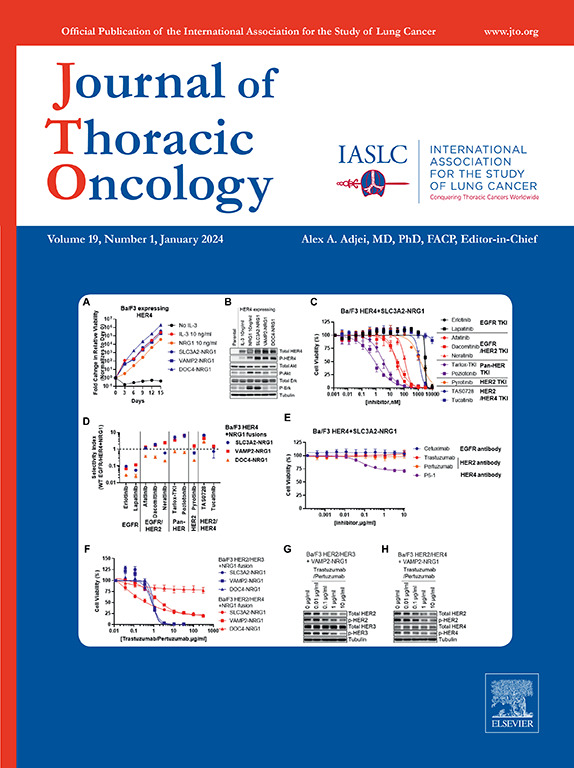循环肿瘤DNA分析可预测无法切除的III期非小细胞肺癌短程巩固免疫疗法的疗效
IF 21
1区 医学
Q1 ONCOLOGY
引用次数: 0
摘要
导言:对于无法手术的 III 期非小细胞肺癌(NSCLC)患者,目前的治疗标准包括化放疗(CRT),然后进行为期一年的检查点抑制剂(CPI)治疗。然而,CPI 巩固治疗的最佳持续时间仍然未知。在这里,我们描述了循环肿瘤DNA(ctDNA)最小残留病灶(MRD)与接受CRT后短程巩固免疫疗法2期试验的不可切除局部晚期NSCLC患者的临床结局之间的关系,目的是测试ctDNA是否能够识别不需要全年治疗的患者:在完成 CRT 后、CPI C2D1 前(即治疗开始后 1 个月)以及长达 6 个月的治疗结束时,收集 BTCRC LUN 16-081 试验患者的血浆样本进行 ctDNA 分析。使用 CAPP-Seq 进行了肿瘤信息 ctDNA MRD 分析。每个时间点的ctDNA水平都与临床结果相关:结果:ctDNA的检测预示着CRT完成后(24个月29% vs 65%,P = 0.0048)、CPI C2D1前(24个月0% vs 72%,P < 0.0001)和CPI结束时(24个月15% vs 67%,P = 0.0011)的无进展生存期(PFS)明显较差。此外,与ctDNA水平升高的患者相比,CPI一个周期后ctDNA水平下降或检测不到的患者的预后更好(24个月PFS 72% vs 0%,P < 0.0001)。结论在巩固 CPI 6 个月前、期间或之后检测到 ctDNA 与不良预后密切相关。我们的研究结果表明,对ctDNA MRD进行分析可以个性化地确定巩固免疫疗法的治疗时间。本文章由计算机程序翻译,如有差异,请以英文原文为准。
Analysis of Circulating Tumor DNA Predicts Outcomes of Short-Course Consolidation Immunotherapy in Unresectable Stage III NSCLC
Introduction
The current standard of care for patients with inoperable stage III non-small cell lung cancer includes chemoradiotherapy (CRT) followed by 1 year of checkpoint inhibitor (CPI) therapy. Nevertheless, the optimal duration of consolidation CPI remains unknown. Here, we characterized the relationship between circulating tumor DNA (ctDNA) minimal residual disease (MRD) and clinical outcomes of patients with unresectable locally advanced non-small cell lung cancer treated on a phase 2 trial of short-course consolidation immunotherapy after CRT, with the goal of testing whether ctDNA may be able to identify patients who do not require a full year of treatment.
Methods
Plasma samples for ctDNA analysis were collected from patients on the Big Ten Cancer Research Consortium LUN 16-081 trial after completion of CRT, before day 1 of cycle 2 (C2D1) of CPI (i.e., 1 mo after treatment start), and at the end of up to 6 months of treatment. Tumor-informed ctDNA MRD analysis was performed using cancer personalized profiling by deep sequencing. Levels of ctDNA at each time point were correlated with clinical outcomes.
Results
Detection of ctDNA predicted significantly inferior progression-free survival after completion of CRT (24-mo 29% versus 65%, p = 0.0048), before C2D1 of CPI (24-mo 0% versus 72%, p < 0.0001) and at the end of CPI (24-mo 15% versus 67%, p = 0.0011). In addition, patients with decreasing or undetectable ctDNA levels after 1 cycle of CPI had improved outcomes compared with patients with increasing ctDNA levels (24-mo progression-free survival 72% versus 0%, p < 0.0001). Progression of disease occurred within less than 12 months of starting CPI in all patients with increasing ctDNA levels at C2D1.
Conclusions
Detection of ctDNA before, during, or after 6 months of consolidation CPI is strongly associated with inferior outcomes. Our findings suggest that analysis of ctDNA MRD may enable personalizing the duration of consolidation immunotherapy treatment.
求助全文
通过发布文献求助,成功后即可免费获取论文全文。
去求助
来源期刊

Journal of Thoracic Oncology
医学-呼吸系统
CiteScore
36.00
自引率
3.90%
发文量
1406
审稿时长
13 days
期刊介绍:
Journal of Thoracic Oncology (JTO), the official journal of the International Association for the Study of Lung Cancer,is the primary educational and informational publication for topics relevant to the prevention, detection, diagnosis, and treatment of all thoracic malignancies.The readship includes epidemiologists, medical oncologists, radiation oncologists, thoracic surgeons, pulmonologists, radiologists, pathologists, nuclear medicine physicians, and research scientists with a special interest in thoracic oncology.
 求助内容:
求助内容: 应助结果提醒方式:
应助结果提醒方式:


